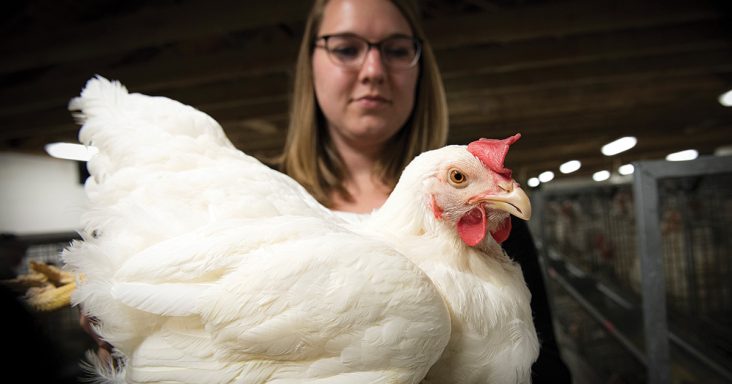Studies point to water efficiency practices in poultry industry
by July 9, 2024 8:33 am 398 views

Sara Orlowski, assistant professor of poultry science, is selecting broilers for water efficiency. Her aim is to breed for birds that maintain consistent feed conversion and weight gain while consuming less water. (U of A System Division of Agriculture photo by Fred Miller)
Global climate change and rising populations will make drinking water more scarce in the coming decades, according to a report from the United Nation’s World Water Development. Nearly one-third of the world’s population has limited or virtually no access to clean drinking water.
The agriculture sector will also face water shortages. Scientists in Arkansas are trying to find ways to conserve water in the poultry industry.
In the first scientific report of its kind, researchers in Arkansas showed that chickens bred for water conservation continued to put on weight despite heat stress that would normally slow growth. The specially bred line of chickens were developed by Sara Orlowski, assistant professor of poultry sciences at the University of Arkansas.
The study, which was part of a five-year project funded by a $9.95 million grant from the U.S. Department of Agriculture’s National Institute of Food and Agriculture, showed a broiler chicken’s physiology could be significantly improved to convert food and water to body weight even with three weeks of heat stress.
Sami Dridi, professor of poultry science specializing in avian endocrinology and molecular genetics, was responsible for conducting the experiment and the driving force in writing the paper. Walter Bottje, professor of poultry science for the experiment station, is the project director for the USDA Sustainable Agriculture Systems multi-institutional grant led by the Center of Excellence for Poultry Science.
Now in its fifth generation of selection, the high water-efficient line has been measured to consume significantly less water than standard broiler lines in use today. From the time they were hatched to one month old, the high water-efficient line drank 1.3 pounds less water, and ate about 5.7 ounces less feed, which calculates to a 32-point improvement in water conversion and six-point improvement in feed conversion when compared to a random-bred control line.
While it may not seem like a huge difference, modern chicken houses hold on average 20,000 to as many as 50,000 birds. Although chickens consume more as they grow, the difference for that month of growing equates to 7,800 fewer gallons of water and 17,800 pounds less feed to grow 50,000 water-efficient chickens.
In some conditions, the high water-efficient chicken had food conversion ratios that were just as good or better, and their water conversion ratio was about 55% to 65% better, according to Dridi.
Bottje said recent results from the ongoing research are promising, but the group aims to investigate other physiological characteristics of the high water-efficient line, such as meat quality and gut integrity.
The researchers devised a study that induced heat stress for groups of chickens by increasing the ambient temperature to mimic a summer season in Arkansas. The heat-stress cycle began when the birds were 29 days old. The environment was also kept between 30% and 40% relative humidity. Dridi ran a parallel study comparing data on the divergent lines of chickens. What they found was surprising.
“What the most interesting thing from that study, when it comes to live performance, is that the heat-stressed birds from the high water-efficient line consumed less water than the non-heat-stressed birds from the low water-efficient line,” Orlowski said.
Water is critical to raising chickens. They can go several days without food, but only a few hours without water at high temperatures, Dridi said.
Dridi said high humidity, which would be over 70% for chickens, also induces similar heat stress because the chickens cool themselves by breathing. Dridi’s studies on poultry house sprinkler systems kept the humidity lower than the industry standard method and used significantly less water than evaporative cooling cells.
“With water sprinkling systems that can save up to 66% water usage in a poultry house, the water conservation of poultry could be improved by a magnitude of three- to four-fold by having chickens that consume less water and still retain growth,” Dridi said.
Dridi said the idea for water-efficient chickens came from looking at the differences in chicken lines bred as far back as the 1950s. Dridi and other researchers wanted to see how much genetic differences there were between jungle fowl and modern breeds.
Before they could breed water-efficient chickens, though, they had to reliably measure the amount of water chickens drank. Orlowski was a doctoral student when her graduate research team developed a novel low-flow water monitoring system in collaboration with Siloam Springs-based companies Alternative Design and Cobb-Vantress Inc., a primary broiler breeder company. The tool was essential to accurately measure water intake for individual birds in real time.
“When we first started this project in 2018, we evaluated one of our broiler lines, a non-selected control population, and we characterized them for water intake,” Orlowski said. “And within that population there was a variability for water intake. From there, we were able to take our most water-efficient families and our least water-efficient families, establish our research populations and continue to select from there.”
A base population of chickens that were not selected for high or low water-efficiency was kept as a control group to compare changes in each generation, Orlowski noted.
Bottje and Dridi said the work done by Orlowski in selecting the divergent lines of chickens was the most important factor of this experiment. Orlowski said water efficiency in the high water-efficient line is continuing to improve with each succeeding generation. She ranks the water efficiency trait as “moderately heritable.”
“There’s no reason that it will not work for all poultry operations, including turkeys, quail and ducks,” Dridi said.
